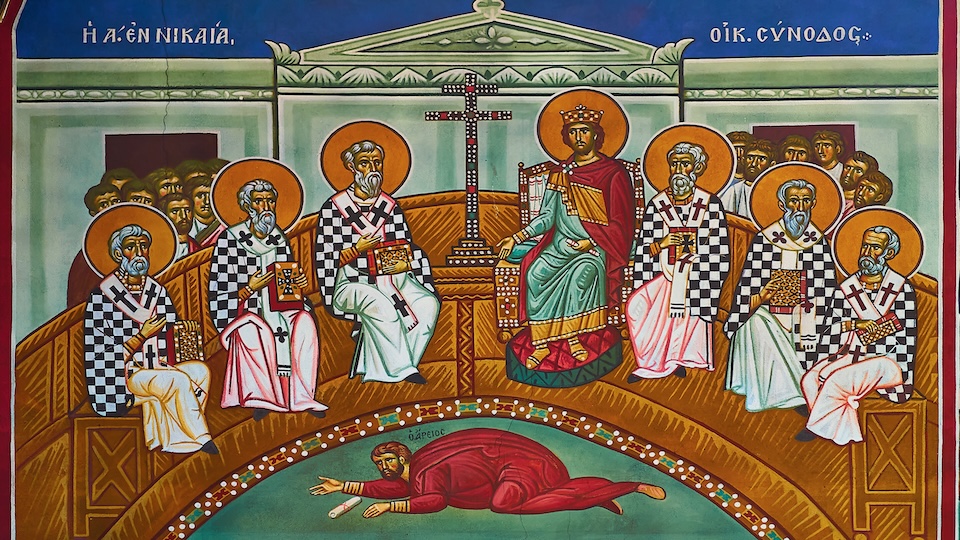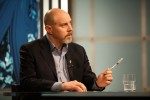

Deacon-structing: What is a Heresy?
Deacon Pedro
Tuesday, November 12, 2024

The condemnation of iconoclasm at the Second Council of Nicaea. Wikimedia Commons.
When I was in the seminary, we had a professor who frequently called us heretics when we expressed an opinion or thought that was clearly out of what the Catholic Church would define as Truth. In that context it was funny as there was no malicious intent, but I sometimes wonder if we too easily fall into the judgemental role of accusing someone of heresy simply because they don’t agree with what our idea of Catholic Teaching is.
So... what exactly is heresy?
The Oxford Dictionary defines heresy as a “belief or opinion contrary to orthodox religious (especially Christian) doctrine.”
The Catholic Church defines heresy as “the obstinate denial or obstinate doubt after the reception of baptism of some truth which is to be believed by divine and Catholic faith.” (Code of Canon Law #751 and Catechism of the Catholic Church #2089)
This second definition is key because it explains how, in order to be a “heretic” the person first has to have been baptised. Then, the person also has to know that the Church teaches what they are denying, what it teaches about it and why. If so, and that person still claims to be a Christian, yet still, publicly (and obstinately) denies or doubts anything that the Catholic Church definitively teaches as divinely revealed (which means it has been defined), through Scriptures or Tradition, ie. Doctrine, either by the Pope (ex-cathedra) or by a Council, and refuses to be corrected, then that person can be called a “formal heretic”.
Someone who holds an opinion which is contrary to the teachings of the Church but is ignorant that the belief is heretical, is merely a “material heretic.” This person is not really a heretic.
Both these people can be said to be in a state of heresy, however the material heretic is not in a state of sin, whereas the formal heretic is.
In his Summa Theologiae, St. Thomas Aquinas writes that heresy is “a species of infidelity in men who, having professed the faith of Christ, corrupts its dogmas.” (II-II:11:1) New Advent explains: “The believer accepts the whole deposit (of faith) as proposed by the Church; the heretic accepts only such parts of it as commend themselves to his own approval.”
To me, Aquinas’ definition captures what we normally mean by heresy more accurately: A heresy is not so much a denial of truth, but rather an overemphasis (or under-emphasis or denial) of one aspect of truth.
Since the time of the Apostles there have been false teachers or those who disagree with or contradict the Faith. St. Peter wrote in his second letter: “But there were also false prophets among the people, just as there will be false teachers among you. They will secretly introduce destructive heresies, even denying the sovereign Lord who bought them—bringing swift destruction on themselves.” (2 Peter 2:1)
As the Church Fathers began defining Teaching, formal heresies also became defined.
Wikipedia lists some 60 heresies. Some that you may have heard of are: Gnosticism, Docetism, Arianism, Pelagianism, Donatism, Nestorianism, Iconoclasm. Manichaeism, Jansenism, and Montanism.
Let’s deacon-struct the main ones:
 Every week, Deacon Pedro takes a particular topic apart, not so much to explore or explain the subject to its fullness, but rather to provide insights that will deepen our understanding of the subject. And don’t worry, at the end of the day he always puts the pieces back together. There are no limits to deacon-structing: Write to him and ask any questions about the faith or Church teaching: [email protected]
Every week, Deacon Pedro takes a particular topic apart, not so much to explore or explain the subject to its fullness, but rather to provide insights that will deepen our understanding of the subject. And don’t worry, at the end of the day he always puts the pieces back together. There are no limits to deacon-structing: Write to him and ask any questions about the faith or Church teaching: [email protected]
Gnosticism (1st C)
is a broad and diverse movement that generally teaches that divine souls are trapped in a material world and that the material world is evil and salvation is achieved through personal secret knowledge (gnosis). Basically, it is the idea that the spirit is good and the body is bad. Gnostics often denied the goodness of creation and the incarnation of Christ. Gnostic ideas reject Catholic teaching on the nature of God, the incarnation of Christ, the goodness of creation and the means to salvation. Many other heresies fall under the larger category of gnosticism. Contemporary New Age spirituality, with its emphasis on esoteric knowledge and often dualistic worldview, bears similarities to ancient Gnosticism.Docetism (AD 197)
comes from the Greek word that means “illusion.” It is a gnostic belief that states that Jesus was so divine that his human form only seemed human and was an illusion. Docetism was also condemned by the Council of Nicaea, as it also rejects the Equal Divinity/Humanity of Christ. This heresy would also deny the notion that Jesus truly suffered for our sins and that the Eucharist is not really the flesh of Christ. The gnostic belief that the material world is flawed or evil has echoes of docetism. Modern religions that teach that the material world is an illusion and de-emphasize physical suffering preach docetism.Arianism (AD 256)
is attributed to Arius, a priest from Alexandria, Egypt. He taught that even though Jesus is the Son of God, begotten by the Father, He did not always exist and is not co-eternal with the Father. This is in deep contrast to the Catholic Doctrine of the Divinity of Christ and the Doctrine of the Trinity. Arianism was condemned by the First Council of Nicaea which defined the Nicene Creed. Anyone today who thinks that Jesus was not really divine, that he was just a good man or a great prophet, are modern-day Arians.Pelagianism (AD 355)
denied that divine Grace in the soul is necessary to do good and denied original sin and the necessity of Grace for salvation. Augustine contested Pelagius. The Catholic Church teaches that salvation is a gift from God and cannot be earned by human effort alone. Many people today (some Christians included) overemphasize human potential and moral effort, a type of self-help spirituality, over divine Grace in achieving salvation (“we can get to Heaven just by being good,” for example). These are pelagianistic views.Donatism (4th C)
is a belief led to a schism in the region of Carthage that lasted from the 4th to the 6th centuries. The sect maintained that the Church must be a Church only for saints, not sinners, and that the validity of sacraments depends on the moral purity of the clergy who administer them. Donatists also had no mercy for anyone who lapsed (or apostatized, denied the faith) during persecution, barring their ability to return to the Church even after Confession. Donatism challenges the teachings on the nature of the Church and the sacraments. Fundamentalists or purists who stress moral or doctrinal purity in order to receive the Eucharist, for example, can be classified as modern-day pseudo-donatists.Nestorianism (AD 450)
is associated with Nestorius, the Patriarch of Constantinople, and emphasizes the disunion between the human and divine natures of Jesus. Nestorians believed that there were two separate persons, one human and one divine, in Christ. It was condemned by the Council of Ephesus in 431 AD, which affirmed the unity of the person of Christ: Christ is one person with two natures, fully divine and fully human, perfectly united.Iconoclasm (Condemned by Nicaea II in 787)
rejects the veneration of religious images and icons, seeing them as idolatrous. Some congregations today, particularly in their more radical forms, reject the use of religious imagery and statues.They view them as contrary to Biblical teachings against idolatry, using Scripture such as Exodus 20:4-5 to justify it:"You shall not make for yourself an image in the form of anything in heaven above or on the earth beneath or in the waters below. You shall not bow down to them or worship them; for I, the Lord your God, am a jealous God, punishing the children for the sin of the parents to the third and fourth generation of those who hate me."The key argument against iconoclasm is the Doctrine of the Incarnation. Christ incarnate is an “icon” to the Divine. It also fails to make a distinction between veneration and worship. We venerate images; we worship God alone.
Jansenism (17th C)
is named after Dutch bishop and theologian Cornelius Jansen. It so strongly emphasized original sin, the necessity of divine Grace, and predestination, that it denied the role of free will. The Catholic Church teaches that even though there is a primacy of Grace, freewill is necessary; we cooperate with Grace. Those today that emphasize a moral rigor and have a pessimistic view of human nature have pseudo-Jansenists beliefs. It is very hard to know the fullness of Catholic Teaching, and sometimes to have a clear sense of what is fundamental to our Catholic beliefs and what is not. In Deacon-structing Doctrine part 2: The List, I explain the hierarchy of Truths and list the five foundational truths. It might be a helpful companion to this article. It is also good to remember that the mystery of the Most Holy Trinity is the most fundamental and essential Teaching (CCC #234). That may explain why so many of the heresies listed above have to do with denying some aspect of the Trinity. Right from the Book of Genesis, we had the serpent inviting us to question the nature and personhood of God. Did God really say that? Is that who God really is? Surely God didn’t mean that? The devil’s main objective is to deceive and deception is best done with half-truths – they sound like truth, but they are not entirely truth. Ultimately, that is what a heresy is: It sounds good and could be true; it may even sound like Doctrine, but it is not exactly true; it is partially false. May we always have a desire for Truth and that in seeking it we may find Christ, and in finding Christ, we may seek the Truth more. Every week, Deacon Pedro takes a particular topic apart, not so much to explore or explain the subject to its fullness, but rather to provide insights that will deepen our understanding of the subject. And don’t worry, at the end of the day he always puts the pieces back together. There are no limits to deacon-structing: Write to him and ask any questions about the faith or Church teaching: [email protected]
Every week, Deacon Pedro takes a particular topic apart, not so much to explore or explain the subject to its fullness, but rather to provide insights that will deepen our understanding of the subject. And don’t worry, at the end of the day he always puts the pieces back together. There are no limits to deacon-structing: Write to him and ask any questions about the faith or Church teaching: [email protected]Related Articles:
<<













